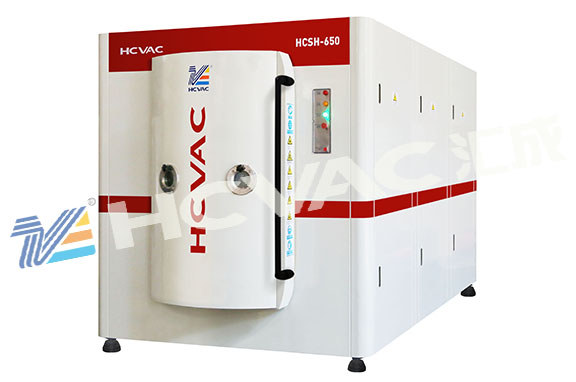pvd coating machine cleaning is generally carried out before the vacuum process is applied, and stains are first removed from the surface of the workpiece or system material. Surface cleaning of vacuum parts is very necessary, because the gas and vapor sources caused by contaminants can make the vacuum system unable to obtain the required vacuum degree. In addition, due to the presence of contaminants, it will also affect the strength and sealing performance of vacuum component connections. Therefore, before the vacuum coating machine is put into use, the cleaning process is essential. So what are the cleaning methods for cleaning the coating machine? Here are a few of them.

First: discharge cleaning, this cleaning method is widely used in the cleaning and degassing of high vacuum and ultra-high vacuum systems. Especially used in vacuum coating equipment. Use hot wire or electrode as electron source. Applying a negative bias to the surface to be cleaned can achieve gas desorption by ion bombardment and removal of some hydrocarbons. The cleaning effect depends on the electrode material, geometry and its relationship to the surface. That is, it depends on the number of ions and ion energy per unit surface area. Thereby it depends on the effective electrical power. The vacuum chamber is filled with an inert gas (typically Ar gas) of an appropriate partial pressure. Cleaning can be achieved by bombardment of ions by glow discharge at low voltage between two appropriate electrodes
Second: vacuum heating and cleaning, place the workpiece under normal pressure or vacuum for heating. To promote the evaporation of volatile impurities on the surface to achieve the purpose of cleaning, the cleaning effect of this method is related to the environmental pressure of the workpiece, the length of the retention time in the vacuum, the heating temperature, the type of contaminants and the material of the workpiece. The principle is to heat the workpiece. Promote the enhanced desorption of water molecules and various hydrocarbon molecules adsorbed on its surface. The degree of desorption enhancement is temperature dependent. Under ultra-high vacuum, in order to obtain atomically clean surfaces, the heating temperature must be higher than 450 degrees. The heating cleaning method is particularly effective. But sometimes, this approach can also have side effects. As a result of heating, it may occur that some hydrocarbons aggregate into larger agglomerates and at the same time decompose into carbon residues.
Third: nitrogen flushing
When nitrogen is adsorbed on the surface of the material, due to the small adsorption energy, the surface retention time is extremely short. Even if it is adsorbed on the wall of the device, it is easy to be pumped away. Using this property of nitrogen to flush the vacuum system can greatly shorten the pumping time of the system. For example, before the vacuum coating machine is put into the atmosphere, first fill the vacuum chamber with dry nitrogen to flush it and then fill it into the atmosphere, the pumping time of the next pumping cycle can be shortened by nearly half, because the adsorption energy of nitrogen is far Smaller than water vapor molecules, after being filled with nitrogen under vacuum, nitrogen molecules are first adsorbed by the vacuum chamber wall. Since the adsorption site is fixed, it is filled with nitrogen molecules first, and there are very few water molecules adsorbed, thus shortening the pumping time. If the system is polluted by the oil splash of the diffusion pump, nitrogen flushing method can also be used to clean the polluted system. Generally, while baking and heating the system, flushing the system with nitrogen gas can eliminate the oil pollution.
Fourth: reactive gas flushing
This method is particularly suitable for internal washing (removal of hydrocarbon contamination) in large ultra-high stainless steel vacuum systems. Usually, for the vacuum chambers and vacuum components of some large ultra-high vacuum systems, in order to obtain atomically clean surfaces, the standard methods to eliminate surface contamination are chemical cleaning, vacuum furnace roasting, glow discharge cleaning and original energy roasting vacuum systems and other methods. The cleaning and degassing methods described above are commonly used before and during assembly of a vacuum system. After the vacuum system is installed (or after the system is in operation), since the various components in the vacuum system have been fixed, it is difficult to degas the various components in the vacuum system. Once the system is (accidentally) contaminated (mainly large atomic numbers) Molecules such as hydrocarbon contamination), usually need to be disassembled, reprocessed and then installed. With the reactive gas process, in-situ online degassing can be performed.
Fifth: UV radiation cleaning, using UV radiation to decompose hydrocarbons on the surface. For example, exposure to air for 15 hours produces a clean glass surface. If properly pre-cleaned surfaces are placed in an ozone-generating UV source. A clean surface can be created in minutes (process clean). This indicates that the presence of ozone increases the cleaning rate. The cleaning mechanism is: under ultraviolet irradiation, the dirt molecules are excited and dissociated, and the generation and existence of ozone produces highly active atomic oxygen. Excited dirt molecules and free radicals generated by dirt dissociation interact with atomic oxygen. The formation of relatively simple and volatile molecules. Such as H203, CO2 and N2. The reaction rate increases with the increase of temperature.
The above are several methods introduced for you, I hope to help you to understand and improve the cleaning of
pvd coating machine.



